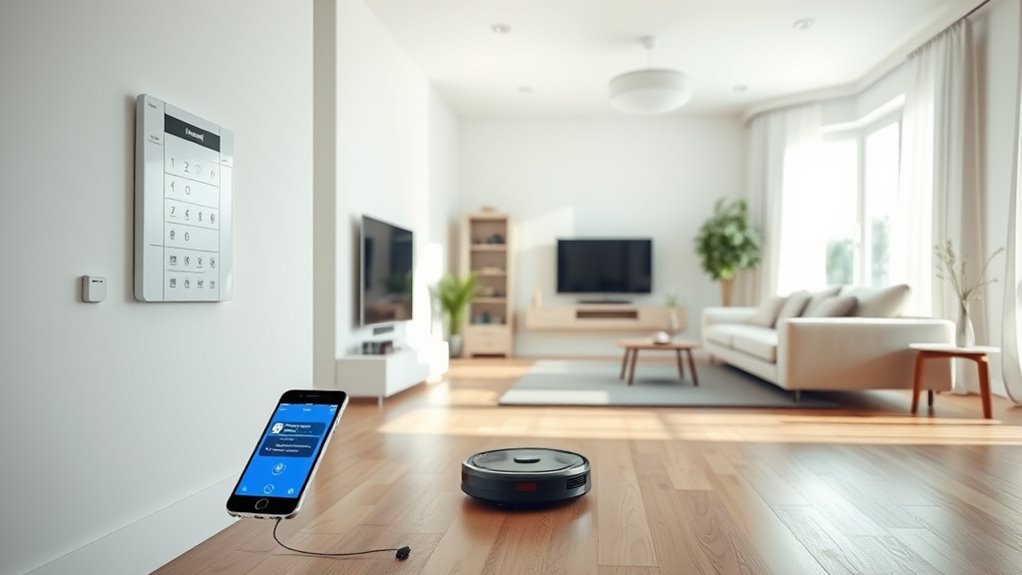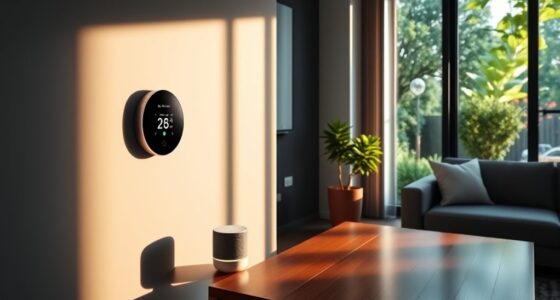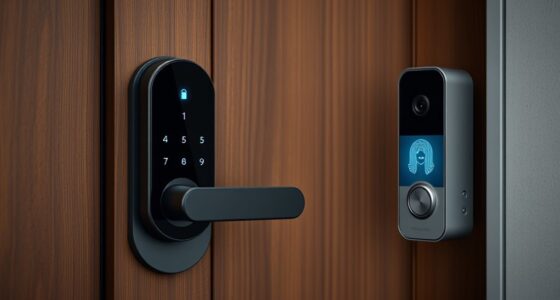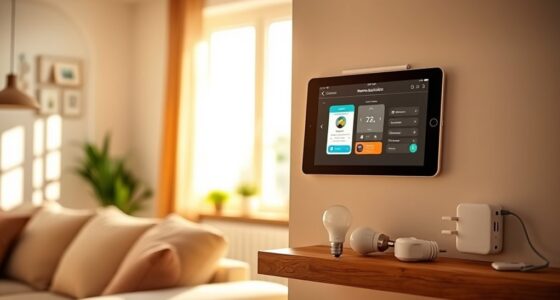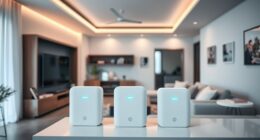Automating home maintenance with smart sensors lets you detect issues early and respond automatically, saving time and money. Properly placing and configuring sensors like motion, humidity, or leak detectors helps make certain data is accurate and quick alerts. When integrated with your home automation system, these sensors provide real-time insights and trigger actions like shutting off water or adjusting climates. Keep sensors updated and secure to maintain reliability — exploring more will show you how to make this process seamless.
Key Takeaways
- Proper sensor placement enables early detection of issues like leaks, humidity, or electrical faults, facilitating proactive maintenance.
- Automated alerts from smart sensors notify homeowners immediately about potential problems, reducing manual monitoring needs.
- Integrating sensors with home automation systems allows for automatic responses, such as shutting off water or adjusting HVAC settings.
- Regular calibration and firmware updates ensure sensor accuracy, preventing false alarms and ensuring reliable maintenance triggers.
- Smart sensors support maintenance scheduling and real-time monitoring, extending system lifespan and preventing costly repairs.
Understanding Different Types of Smart Sensors

Have you ever wondered how smart sensors detect changes around your home? It all starts with sensor placement. Proper placement ensures accurate readings, whether it’s a motion sensor near entryways or a temperature sensor in the attic. Different sensors serve various purposes, like detecting motion, humidity, or leaks. Understanding these types helps you choose the right ones for your needs. While smart sensors offer convenience, data privacy is essential. You should know where your data is stored and how it’s protected, especially since sensors collect sensitive information. Whether wired or wireless, each sensor type has unique features, but effective placement and sensor types can help you better interpret the data they provide and ensure optimal performance. Incorporating security features like encryption and user profile management can further safeguard your data. Additionally, being aware of power sources can help in choosing sensors that fit your home’s infrastructure and energy efficiency goals. Being familiar with sensor technology can also assist in troubleshooting and maintaining your smart home system effectively.
Setting Up and Configuring Your Sensors
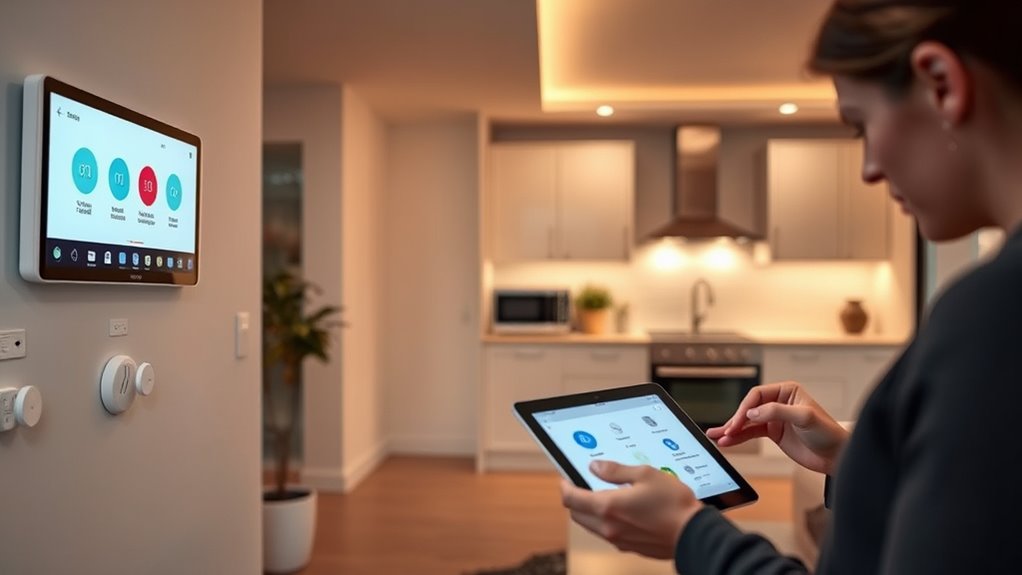
To guarantee your smart sensors function correctly, you need to carefully set them up and configure their settings. Start by ensuring each sensor is properly calibrated; this step is vital for accurate readings and reliable performance. Follow the manufacturer’s instructions for sensor calibration, adjusting sensitivity as needed. Next, establish a stable wireless connectivity setup, whether through Wi-Fi or Zigbee, to enable seamless communication with your home network. Ensure your sensors are within range and have strong signals to prevent dropouts or false alerts. Once connected, update firmware and customize settings such as alert thresholds or measurement intervals. Proper setup and configuration are essential to maximize your sensors’ effectiveness and ensure smooth automation of your home maintenance tasks. Additionally, consider headphone compatibility to ensure clear communication during setup and troubleshooting. Incorporating automation’s role in business intelligence concepts can help optimize sensor data analysis for better maintenance scheduling.
Integrating Sensors With Home Automation Systems

After properly setting up and calibrating your sensors, the next step is to integrate them with your home automation system. Accurate sensor calibration ensures reliable data collection and seamless communication. Most systems support integration through compatible hubs or apps, allowing you to connect sensors via Wi-Fi, Zigbee, or Z-Wave. During integration, double-check your device settings and update firmware if necessary. It’s essential to contemplate data privacy; choose a system that encrypts data and offers secure remote access. Use strong passwords and enable two-factor authentication if available. Proper integration ensures your sensors work harmoniously within your smart home ecosystem, providing real-time insights and automation capabilities. This step lays the foundation for efficient, secure home maintenance automation.
Monitoring and Responding to Sensor Alerts

How can you guarantee your home stays safe and maintained when sensor alerts go off? The key is effective monitoring and response. First, ensure your sensors are properly calibrated; inaccurate readings can cause unnecessary alerts or missed issues. Next, customize alerts to suit your needs, prioritizing critical notifications. When an alert sounds:
- Check sensor calibration to confirm accuracy
- Review alert details promptly
- Decide whether to address the issue immediately or schedule maintenance
- Use automation to trigger specific responses, like shutting off water in leaks
- Keep a log of alerts for future reference
- Staying informed about privacy and cookie usage measures can help protect your personal data from cyber threats.
- Regularly testing your sensors can help maintain their accuracy and reliability, preventing false alarms or missed detections.
- Incorporating durable and high-quality sensors can enhance overall system performance and longevity.
- Additionally, understanding sensor limitations can guide proper system setup and prevent unnecessary disruptions.
Benefits of Automated Maintenance for Homeowners
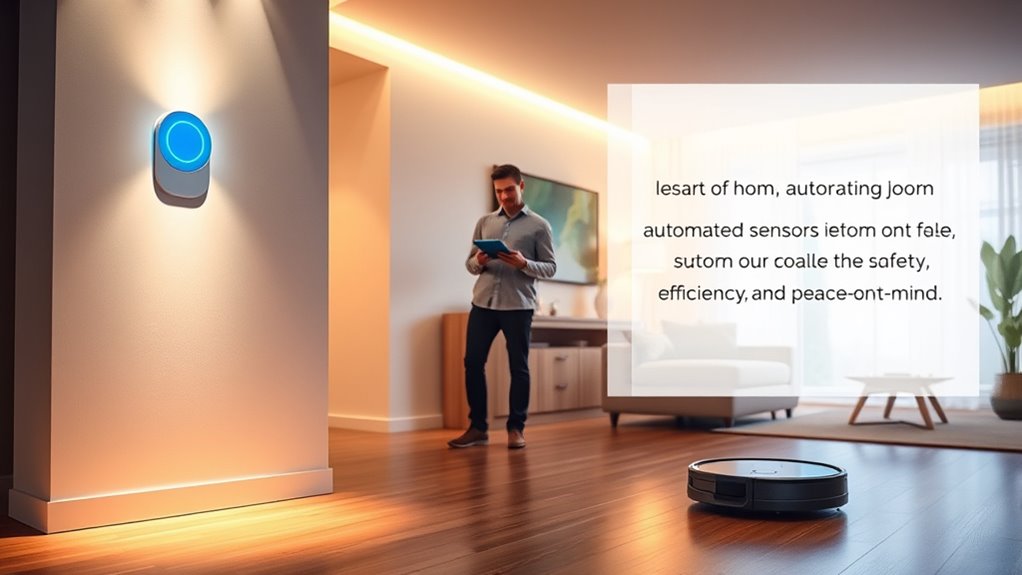
Automated maintenance offers homeowners a reliable way to keep their homes in top condition without constant manual oversight. By strategically placing sensors throughout your home, you guarantee early detection of issues like leaks, electrical problems, or HVAC inefficiencies. This proactive approach allows your system to automatically adjust or alert you when maintenance is needed, saving you time and stress. Automated maintenance also helps you stick to maintenance schedules, preventing costly repairs caused by neglect. With sensors in key areas, you gain real-time insights, reducing the risk of unexpected breakdowns. Additionally, vetted options for portable camping gear demonstrate how modern technology can enhance outdoor experiences, just as smart sensors improve home maintenance. Incorporating preventative measures through automation increases the longevity of your home systems and reduces emergency repairs. Embracing cybersecurity best practices can help protect your smart home devices from vulnerabilities, ensuring your automation remains secure. Furthermore, integrating home health monitoring features can provide comprehensive insights into your home’s overall condition, making maintenance even more efficient. Modern sensor technology also enables continuous monitoring, which ensures ongoing oversight without manual checks. Overall, this technology offers peace of mind, greater efficiency, and long-term savings by keeping your home running smoothly with minimal effort on your part.
Frequently Asked Questions
How Secure Are Smart Sensors Against Hacking or Data Breaches?
Smart sensors can be vulnerable to hacking or data breaches, so you should be aware of privacy concerns. Many devices use sensor encryption to protect your data, but no system is completely foolproof. You can improve security by updating firmware regularly, using strong passwords, and enabling two-factor authentication. Staying informed about potential vulnerabilities helps you manage risks and keeps your smart home safer from unauthorized access.
Can Smart Sensors Operate Effectively in Extreme Weather Conditions?
Can smart sensors operate effectively in extreme weather conditions? You’ll find that weather resilience varies depending on sensor design and installation. Proper sensor calibration guarantees accuracy despite temperature swings, humidity, or heavy rain. Look for sensors built with durable materials and advanced protection features. Regular calibration and maintenance also help keep them functioning reliably. With the right setup, you can trust your smart sensors to perform well, no matter the weather outside.
What Is the Typical Lifespan and Battery Life of Home Smart Sensors?
You might wonder about the sensor durability and battery longevity of your smart sensors. Typically, these sensors last 3 to 5 years, depending on usage and environmental factors. Battery life varies; some can operate for up to a year on a single charge or replaceable batteries. Proper maintenance and choosing high-quality sensors can enhance durability and extend battery longevity, ensuring your home automation runs smoothly over time.
Are Smart Sensors Compatible With All Home Automation Brands and Systems?
You might wonder if smart sensors work seamlessly with your existing home automation system. Compatibility varies by brand, so it’s essential to check the manufacturer’s specifications. Many sensors support popular platforms like Alexa, Google Home, or Apple HomeKit, ensuring smooth sensor integration. However, some brands may have limited compatibility, so always verify brand compatibility before purchasing to guarantee your smart sensors work effortlessly with your current setup.
How Much Do Smart Sensors and Their Installation Generally Cost?
Smart sensors typically cost between $20 and $100 each, depending on features and brand. Installation expenses vary based on complexity, often ranging from $50 to $200 per sensor. When doing a cost comparison, consider both the purchase price and installation costs. While some systems may require professional setup, others are DIY-friendly, helping you save on installation expenses. Overall, budgeting for smart sensors involves balancing device costs with installation needs.
Conclusion
By automating home maintenance with smart sensors, you’re taking control and preventing costly repairs before they happen. Did you know that homes with smart sensors experience a 30% reduction in emergency repairs? This technology not only saves you money but also gives you peace of mind, knowing your home is constantly monitored and protected. Embrace automation today and enjoy a safer, more efficient living environment.

